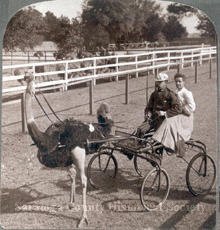Stereoscope (only one half pictured) of ostrich harnessed to a cart on a Jacksonville, Florida ostrich farm. 
One of the more interesting footnotes to Saratoga’s history is the short-lived ostrich farm that graced Ballston Avenue. This farm was the summer home of the Florida Ostrich Farm. While little evidence has been uncovered in local sources to document the ostrich farm, they were well-known in their farms’ state of origin, Florida. In the United States, ostrich farms fulfilled a dual role as tourist destinations and a source for elegant feathers used in high fashion dress. Millinery establishments in Saratoga Springs, such as Mrs. M.A. Mitchell at 454 Broadway, and Mrs. M.F. Mart at 417 Broadway, advertised various kinds of feather for trimming hats. One of the main attractions of the Florida Ostrich Farm (at least according to the brochure) was the opportunity to purchase feathers directly from the producer. As a tourist destination, a souvenir booklet in Brookside’s collection describes in poetic detail what a typical visitor might see: ” . . . our farm now contains over two hundred ostriches ranging from seven to ten feet high and weighing from two hundred and fifty to four hundred pounds each to the little chicks out of the shell. The magnificent birds on this farm bear little resemblance to the undersized, bedraggled, and usually solitary specimens to be seen in traveling menageries and zoological gardens . . . All of our older birds are named for the most part with cognomens that are calculated to tickle the fancy of the visitor.”
Descriptions of the farm set up sound positively palatial for the birds. Mated pairs were kept together in corrals for breeding purposes. The younger birds who had not yet been mated were kept in a large enclosure and were allowed to wander in a group. According to the writer of the pamphlet, male ostriches became quite vicious during the mating season and had been known to “dangerously wound a man with a blow of the foot.” Safety practices for dealing with an enraged ostrich were described thus: “A certain amount of safety in case of an attack by one of these hugh[e] birds can only be secured by lying flat on the ground, as they can kick dangerously only at a height of about three feet and over.” Plucking took place in a narrow enclosure and with a bag slipped over the head of the bird.
Oliver W., an ostrich of the Florida Ostrich Farm and pictured above, gave “daily exhibitions at our Jacksonville farm during the winter tourist season. He has spent the past three summers at our Saratoga farm, and during his sojourn in the North gave successful track exhibitions at many of the principal fairs throughout New York, New Jersey, Connecticut, Massachusetts, and Canada. Hitched to a pneumatic tired racing wagon he was driven two half-mile heats daily, against a a saddle horse, and in each instance this exhibition proved to be the chief drawing card amongst the day’s list of attractions.” Ostrich racing was undoubtedly a difficult and short-lived spectacle as ostriches are intractable and, well, stupid.
The farm in Saratoga was located on Ballston Avenue and became merely an anecdotal part of the tourist industry in this area around 1900-1910.
Most of the above text adapted from a presentation by Rebecca Hammell, Acting Director of Brookside Museum, 1993. Full text available in Brookside’s vertical files.
Gift of Chris Morley
Photographed by Underwood and Underwood in 1905
















